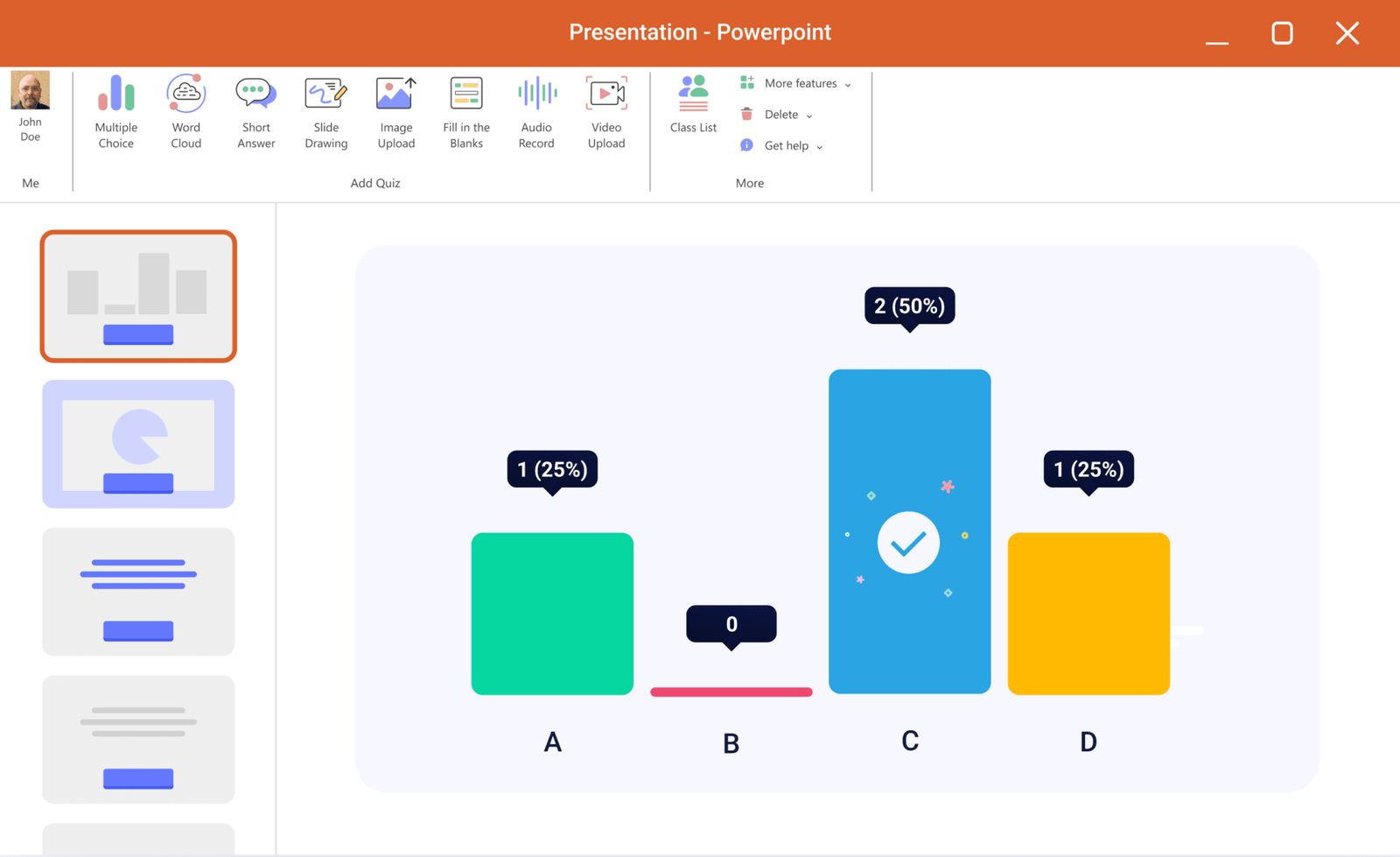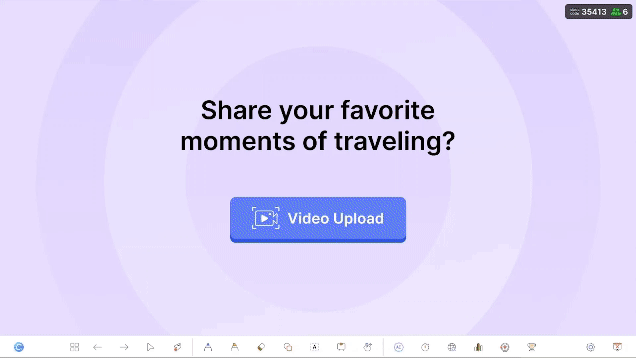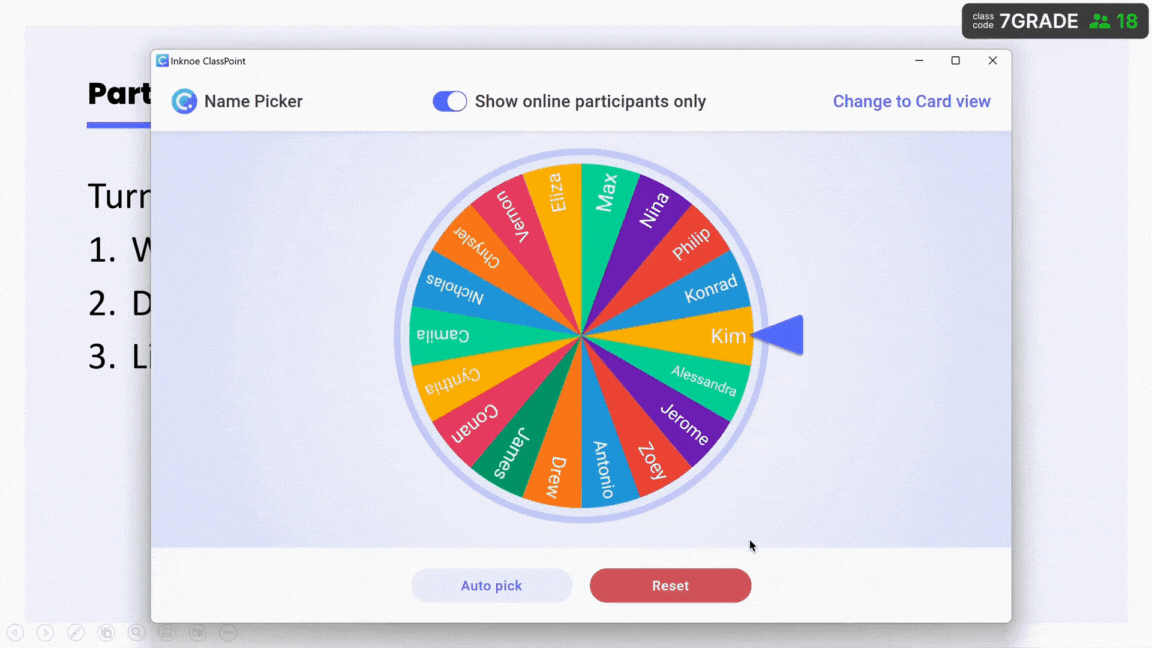Classroom learning works best when students get to show what they know. It’s a two-way street. You, as a teacher, get to speak, and students should also get to do the same.
But one might argue: they’re already speaking in recitations. Indeed, they are. But student presentations are much different.
When students present, they’re doing more than just speaking memorized knowledge out loud. During presentations, they’re organizing ideas impromptu, and learning how to communicate ideas in front of a crowd, no matter how familiar that crowd is.
But many students feel nervous about presenting. Anxious students rush through their slides. Shy students avoid eye contact altogether. And if we just assign student presentations without support, we’re setting students up to struggle or worse, to walk away feeling even more uncomfortable next time.
Instead, let’s treat student presentations as a skill that grows over time. With structure, practice, and the right tools, every student can improve.
Let’s look at how.
1. Make student presentations an expected part of the learning process
Student presentations are often seen as a challenge and sometimes, even punishment. That’s the first thing that needs addressing.
Much like a quiz or an exam, student presentations should be framed as a normal part of how students show what they know simply because it just is, like any other assessment.
Presentations can assess understanding much like recitations do, maybe even more so, because students have to explain their thinking out loud and in order. It’s not a task to be afraid of or get negative reactions about.
When you start talking about student presentations this way, students stop seeing them as something to avoid. Instead, they start preparing for them like they would for any test. You have to make students understand this from day one.
Set the expectations early. That way, students know it’s coming and understand that it’s just part of the course, not a surprise challenge they have to accomplish.
As you’re making this clear, give them structure. Give them a rubric with clear performance levels, like this:
| Category | Needs Work | Good | Excellent |
|---|---|---|---|
| Content Clarity | The explanation is unclear or hard to follow. | Most ideas are explained clearly. | Ideas are explained clearly and concisely. |
| Organization | Ideas jump around. No clear flow. | Ideas follow a logical order most of the time. | Ideas are well-organized with a clear structure. |
| Delivery | Speaks too quietly or too fast. Avoids eye contact. | Speaks clearly most of the time. Makes some eye contact. | Speaks confidently. Maintains eye contact. Uses steady pace. |
| Visuals | Slides are cluttered or distracting. | Slides support the message but may have some distractions. | Slides are clean, readable, and support the presentation well. |
| Time Management | Presentation is too short or too long. Key points rushed or skipped. | Stays mostly within time limits. Some parts feel rushed. | Presents within the given time. Covers all key points without rushing. |
So don’t just tell students to present. Show them what excellent looks like, and help them get there.
2. Introduce them to the right presentation tools
It’s easy to get caught up with the many presentation tools out there. And you probably already are using a handful of them.
As a teacher, juggling multiple tools can serve its purpose. But for students, who are merely beginners in presentations, this can be deemed unnecessary.
Depending on your existing classroom technology, pick out the best presentation tool that seamlessly integrates with whatever resource you already have available:
- If your classroom is familiar with Google Slides, consider staying within that ecosystem.
- If you often use web-based presentation tools, there are several options worth exploring. Canva, Prezi, and Zoho Show all offer unique features that might suit different student needs.
It depends on what tools you already use in class. That’s what students will get familiar with fastest.
If you’re using PowerPoint to deliver presentations, like most do, consider adding ClassPoint to your PowerPoint so students can also use it.

ClassPoint lives right inside PowerPoint. And instead of the usual, static presentation slides, you can add live quizzes, polls, drawing tools, and even AI-generated questions on the fly.
When students see you using these features regularly, it makes it easier for them to make their own student presentations as interactive and engaging.
While in the topic of presentation tools, check out our list of The 12 Best Free AI PowerPoint Generators.
3. Establish that interactivity in presentations is king
Yes, presentations are centered on the actual information being presented. But delivery plays a huge role, too.
Let’s not move too far from that idea. With ClassPoint, as introduced above, student presentations can become more interactive. Students can embed quizzes, ask follow-up questions, and even run live polls during their presentations.
Running a ClassPoint quiz as a presenter is simple. Students can easily adapt to it and use it during their own presentations.
Check out how easy it is to run your first interactive ClassPoint quiz in PowerPoint.
During student presentations, presenters can throw out questions directly to audience devices whether it be:
- Popular question types like multiple choice, short answers, and fill in the blanks
- Multimedia types like slide drawing, image upload, and audio record
- Creative pulse checks with word cloud and quick poll

Pair these up with a point system right inside PowerPoint, and your students are golden.
For active participation, they can award stars to their audience, and even showcase a visual scoreboard right after to acknowledge top participants.
To help spark inspiration, we've put together 10 Easy Ways To Gamify Lessons in PowerPoint you can check out.
4. Allow them to freestyle during presentations
We’ve concluded that giving students structure is a must. But let’s not get that twisted with allowing them to freestyle.
Structuring student presentations to make them a natural part of the learning process is different from letting students take their own route during the actual presentation.
Even as teachers, we all have different ways to present. We use different voices, different commands, different delivery styles. Students must have the same freedom, too.
Going back to ClassPoint, it gives students more than enough tools to freestyle their presentations with dynamic slideshow features they can use live, while presenting.
They can make use of:
- Draggable Objects – to make PowerPoint elements movable around slides
- Name Picker – to randomly select audience names by spinning a wheel of names
- Timer & Stopwatch – to run a ticking timer during presentations for timed activities
- Embedded Browser – to browse the web and open webpages on the spot, as if it’s part of the presentation

All of these and more can be used without ever leaving PowerPoint, giving students enough room to be spontaneous during their student presentations.
5. Don’t sugarcoat the feedback
If you really want student presentations to improve, don’t just clap and move on.
Yes, students need encouragement. But they also need truthful, targeted feedback that helps them grow.
We do it for essays. We do it for quizzes. So why should presentations be any different?
Tell students what they did well, but don’t hesitate to call out what didn’t work. If a student mumbled the whole time, say so. If the slides were too cluttered, point it out. If they lost the audience halfway through, help them see why.
In fact, when you give them clear, and actionable feedback, you’re showing them that their presentation skills matter just as much as the content they’re learning.
Here’s a simple formula you can follow:
- Start with one thing they nailed.
- Follow up with one thing to improve.
- End with a challenge for next time.
And whenever possible, let their peers chime in too. Set ground rules for respectful, constructive feedback, and model it yourself.
Bonus tip: If you’re using ClassPoint, turn the feedback into a live poll or quick word cloud after every presentation. Ask the class: What was the most effective part of this presentation? or What’s one thing you’d do differently if you were the presenter? The answers can spark real reflection without putting anyone on the spot.
Make no room for vague “good job”s. Give students the kind of feedback that pushes them ten steps forward.
FAQs
How do I make student presentations less stressful for shy students?
Start by reframing student presentations as low-stakes, skill-building opportunities, not performance exams. Offer alternatives like pair presentations or small-group formats to ease them in. Use tools like ClassPoint to allow interaction without the pressure of constant speaking.
How often should students give presentations?
There’s no hard rule, but consistency is key. If student presentations are part of your regular assessment mix (once per unit or project cycle), students will get used to them faster and improve more naturally over time.
Can student presentations work for lower grade levels?
Absolutely. Student presentations aren’t just for high school or college students. With the right support, even elementary students can benefit from speaking in front of their peers and organizing ideas aloud.
What should I do when students copy entire slideshows from the internet?
Plagiarism in student presentations is common when students don’t understand how to synthesize information. Instead of penalizing immediately, guide them on how to reframe source material, cite it briefly in slides, and speak about it in their own words. You can also require “presentation notes” or reflections that show original thinking.
How can I help students who freeze mid-presentation?
Freezing is more common than we think, especially for students with anxiety. Teach students recovery techniques like pausing, deep breathing, or having “reset phrases” they can use. You can even assign a supportive peer to jump in with a question to get them going again.
Should I grade the visuals or focus purely on the speaking?
Both matter, but it depends on your goal. If your learning objective is communication, delivery should carry more weight. However, teaching visual literacy is also part of 21st-century skills. Use your rubric to clarify that balance.
How do I deal with students who don’t take peer presentations seriously?
Start by modeling how to be an active audience. Set clear expectations (e.g., no phones, active listening), and hold the class accountable with participation points or response tasks. Students will mirror your energy and expectations if you treat every presentation like it matters.
